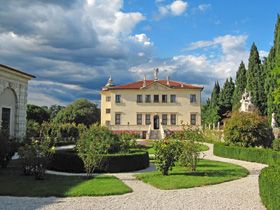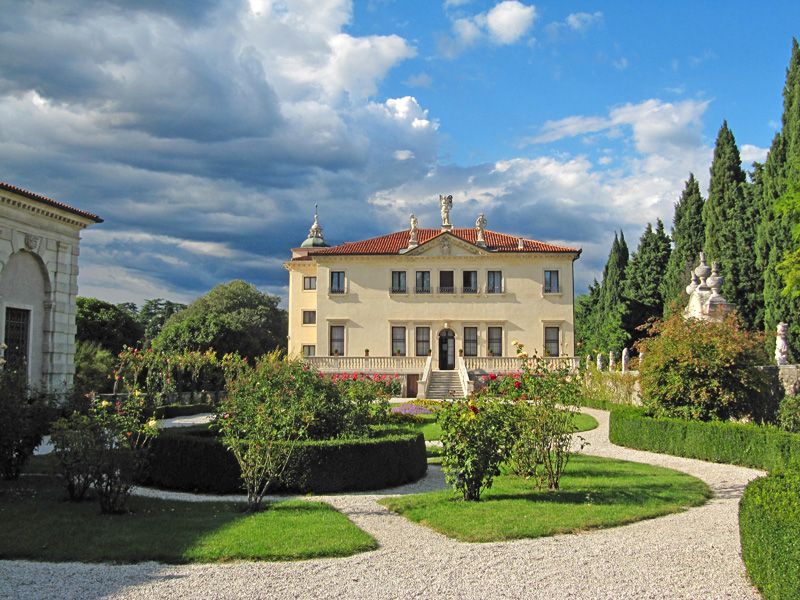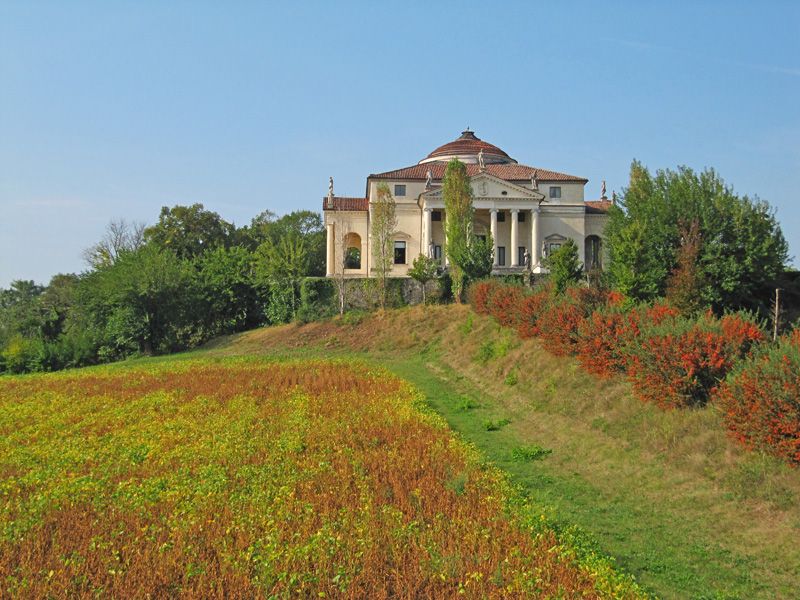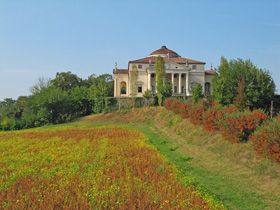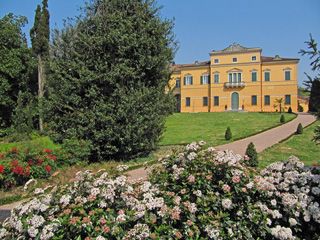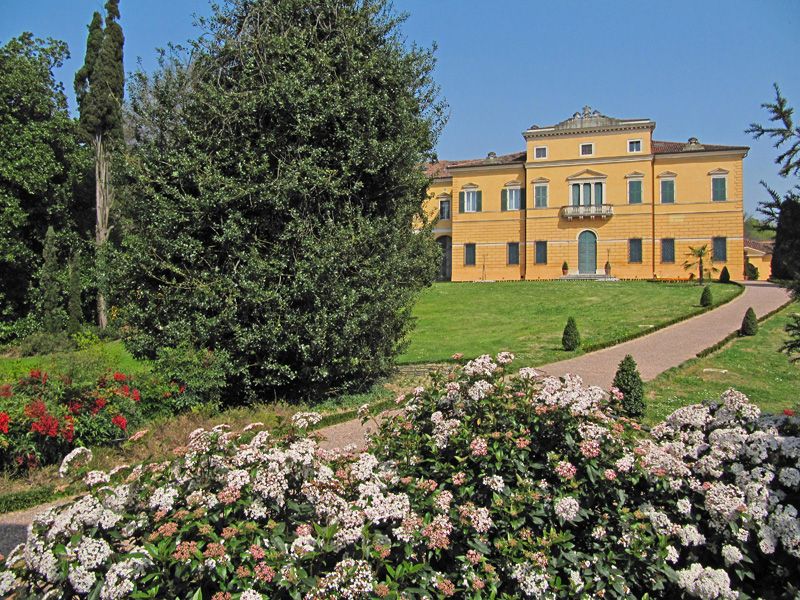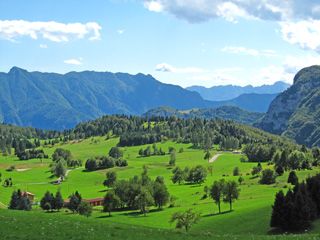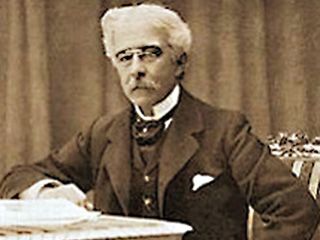Villa Valmarana ai Nani
Walking along a lane flanked by high walls where the tops of cypress trees can be spied you arrive at Villa Valmarana ai Nani, which Fogazzaro called “Villa Diedo”, residence of the Desalles in Fogazzaro’s novel Piccolo mondo moderno (The Man of the World), and the setting for society parties and a passionate encounter between Piero Maironi and Jeanne.
The name actually derives from the statues of dwarves in eighteenth-century costume, attributed to Bendazzoli, which line the top of the perimeter walls of the building which were built by a modest master mason around 1669.
Only when the villa came into the hands of the counts of Valmarana, in the eighteenth century, adding the new entrance, the stables and the “foresteria” or guest quarters, did the villa acquire the imposing appearance which can be still be admired today. The villa owes its fame to its decoration, which was undertaken in 1757 by Giovanni Battista Tiepolo and his son Gian Domenico.
As the salons and rooms were only modestly sized, Tiepolo resorted to the help of the “quadratura” painter Mengozzi Colonna who employed optical illusions to make the ceilings appear higher and the rooms wider. The theme of the paintings is the hero led astray by love and its dire consequences; Tiepolo’s interpretation is rather melodramatic, in a Metastasian sense. In the central salon the sacrifice of Iphigenia is depicted as a consequence of Paris falling in love with Helen, as is the Trojan War. Their vivid colours and the melodramatic pathos which animates each figure make them some of Tiepolo’s most celebrated frescoes. Fogazzaro describes them thus in Piccolo mondo moderno:
[…] the rectangular hall, whose two longest walls are covered by paintings by Tiepolo and show, on one side, Iphigenia between her executioners and the sorrowful princes, and on the other, the Greek crews turning towards the ships in which they are about to embark. The room was but dimly lighted and held an odour of heliotrope and of Cuban cigarettes.
As you enter, the first room on the right is dedicated to Achilles, a range of light colours, recalling a chilly autumn, depicting the light of the sky and wind-tossed sea. The second room on the right relates the tale of the love between Angelica and Medoro, while the second room on the left depicts the loves of Helena and Dido. Finally, in the first room on the left, surrounded by the countryside of the nearby Valletta del Silenzio (Valley of Silence), we find the loves of Rinaldo and Armida and their farewell scene, renowned for its penetrating psychological insight into the characters.
Leaving the villa we come upon the “foresteria” or guest quarters. The Chinese room displays episodes from Turandot, the room of country folk depicts rural scenes, followed by scenes of summer entertainment, the Olympus room, the Carnival room, architectural fantasies and finally the room of the putti, In The Man of the World these rooms are also painted by Tiepolo but are imaginatively renamed by Carlino as, the China of Monsters, the Room of the Georgics, the Hall of Gallantry, Olympus, the Hall of Darwin and the chamber of Anacreon.
The famous writer from Vicenza and great admirer of Fogazzaro, Guido Piovene, brilliantly describes Tiepolo’s work and the scenery around the villa:
In these rooms the onlooker comes face to face with the frescoes, almost on a level with these human and godly figures […] The eighteenth century is never more appealing than when it hints at a future bourgeoisie within an aristocratic fabric, a bourgeoisie with its taste for art as if it were an armchair journey, an invitation to escape, a way of honing your dreams and “for immediate consumption by the heart”. […] lyrical, sensual, magnificent, fantastical, illusionary, theatrical, all these words are suited to Tiepolo. His art presses in on us […] forcing us to feel something: religious fervour, admiration for a principle, for a Nation, for a lavish family, […]. Tiepolo wants to astonish us, disturb us or seduce us. In his paintings he overlays his own vision of nature, bringing new light to it and suggesting new interpretations. Take, for example, his backgrounds, or the small figures in the distance, which glimmer with such tremulous grace. Compared to the figures which stand out so vividly in the foreground, these figures are weightless, they are airy, diaphanous forms which fade into a greyish light. Just as a stage director uses lighting, the artist is deliberately communicating an unreal, pathetic, dream-like quality. […] This is the Tiepolo that gets under our skin. It’s like the memory of a past love. […] in Villa Valmarana I rediscovered the Tiepolo who speaks to me privately. Anyone choosing to contemplate his paintings in a quiet corner, letting his imagination run freely, will feel very comfortable with him. The villa looks over a valley which is quintessential Veneto countryside, no matter how broad or narrow the vista may be, because the whole is subsumed without purporting to sensualise. Through the windows, the meadows and vineyards roll away to the hill-crest. The landscape teased me in the same way as his frescoes, it was both simple and mythological. Tiepolo’s sensuality is all-encompassing, it seeps from every pore, it appears from every quarter, it characterises his world, either real or imaginary. It creeps discreetly, piercingly, neither coarse, nor opinionated, cloaked in many disguises. The characters of the poems, be they warriors or women, young or old, all have the same sensual quality; and so they insinuate their way inside us, becoming our own blood-ghosts, a memory from a time before birth. […] Tiepolo is a painter of skies, or more exactly, he reinvented countless variations of that unique face that is the heavenly vault above us. His painting alone can transport us to a place within the sky […]. He conveys to the spectator a trace of sensual satisfaction with life, the viewer senses that his fantasies and memories are bound to it, there is a proud feeling of personal immortality linked to the flesh.
The entrance and stables are reminiscent of F. Muttoni‘s style, reconciling his Baroque training with Vicenza Palladian style. The stables, in particular, with their three naves and groin vaults on corbel supports, highlight how the architect was able to exploit the hill slope, which drops down sharply from the road towards the valley.
